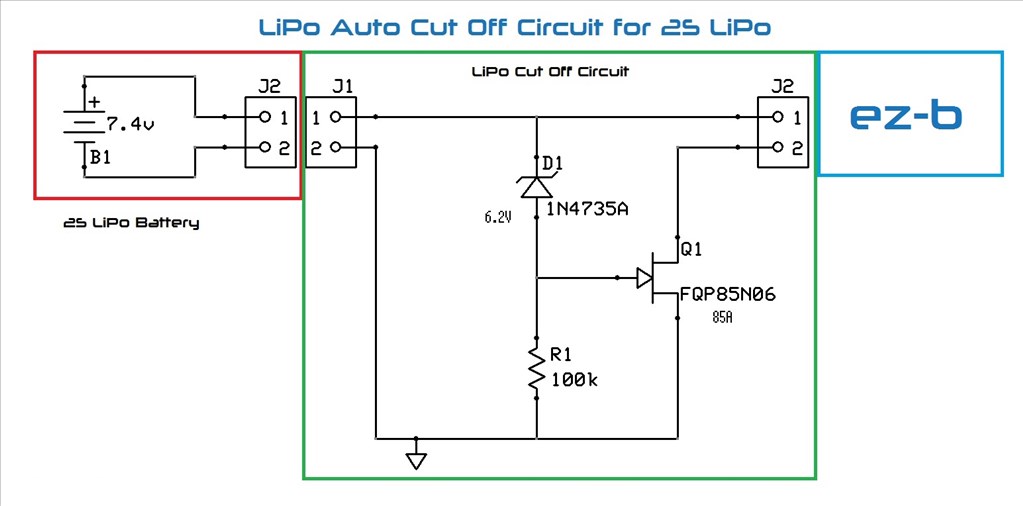Asked
— Edited
Something I've been looking at since I undervoltaged one of my LiPo batteries is an auto cut off circuit when it get's below around 6.2v
I think this will do it but could do with some confirmation since this is not my area of expertise so am always concerned. Any comments and suggestions would be extremely appreciated.
If it is OK you can expect to see this replaced with a tutorial
Zener Diode is rated for 6.2V Mosfet is rated at 85A
I realise a small load may pass through R1 when shut off but I assume it will be so small it will not matter (unless left for a very long period)


Hi Rich, I posted this reply in another post were you had a similar question. Hobbyking sell this device in 2s, 3s, 4s, 5s etc http://www.hobbyking.com/hobbyking/store/__7226__hobby_king_battery_monitor_5s.html
I use it on my bot, it monitors an individual cell rather than the combined battery total. It cost $3.49US It has an LED that flashes when the battery is getting low and a pezo when it reaches the min voltage for the cell.
You could use the pizo signal on the EZ-B as an alarm or hard wire a control relay that drops all power when this pizo alarm goes off.
As for your circuit it looks ok, but be warned the Mosfet will need a heatsink and a fan as the entire current is passing through the mosfet it will generate a reasonable amount of heat, that will buildup inside your bot. So you will need a fan to get rid of it, other wise it will have a negative effect on other electronics in the bot.
ghost
Sorry, Missed you were only running the EZ-b and not the motors etc. It will still need a heat sink, but passive cooling should be enough for the EZ-B load.
I use a lip 2s and one of the HK voltage monitors for audible purposes only.
Ghosty
Well mine will be cutting off the motors and everything but I didn't show that for simplicity (my schematic for power distribution is huge!). That's why I went for an 85A mosfet, it should be big enough to handle any load I will be running.
I was told Mosfets don't generate anywhere near as much heat as transistors and are extremely efficient, but will take your comments into account and throw on a heatsink at the very least, if it seems to be getting too hot in practical tests I'll also add a small fan too (although reluctant due to noise and power usage but we will see).
Thanks I'll order up the parts and give it a real world test. I'm also tempted to throw in an on/off switch on the ground between the mosfet and the battery for manual shut off, not that I plan to turn my robot off once it's done.
I'll order up the parts and give it a real world test. I'm also tempted to throw in an on/off switch on the ground between the mosfet and the battery for manual shut off, not that I plan to turn my robot off once it's done.
I like using this http://www.cainetworks.com/products/webcontrol/index.html to monitor low voltage in each cell and to charge them. LiPo batteries chould be bad if not charged the right way and the cai plc only job is to watch the batteries,and if there is a problem it can email/text me so i can check on them from my phone or even turn it all off.
I have 2 of these running my hottub and home alarm system for a year with no problem
That's not really what I'm trying to achieve. Monitoring is already in place, through the EZ-B. What I am trying to get is extra safety by cutting the power to everything if it drops below a certain level, in this case 6.2V (3.1v per cell, possibly 3.0 & 3.2 if slightly unbalanced).
Do you have cell balancing leads on battery? then you can monitor each cell if you have enough ports on ezb
I already do, I've done a tutorial for the LiPo monitoring board and script. Each cell is monitored through the balance port on to the ADC but that's only good when ARC is running. What I want is a fail safe for if I forget to disconnect the battery.
Perfboard/Stripboard layout for anyone who wants to try it out... bearing in mind this is untested.